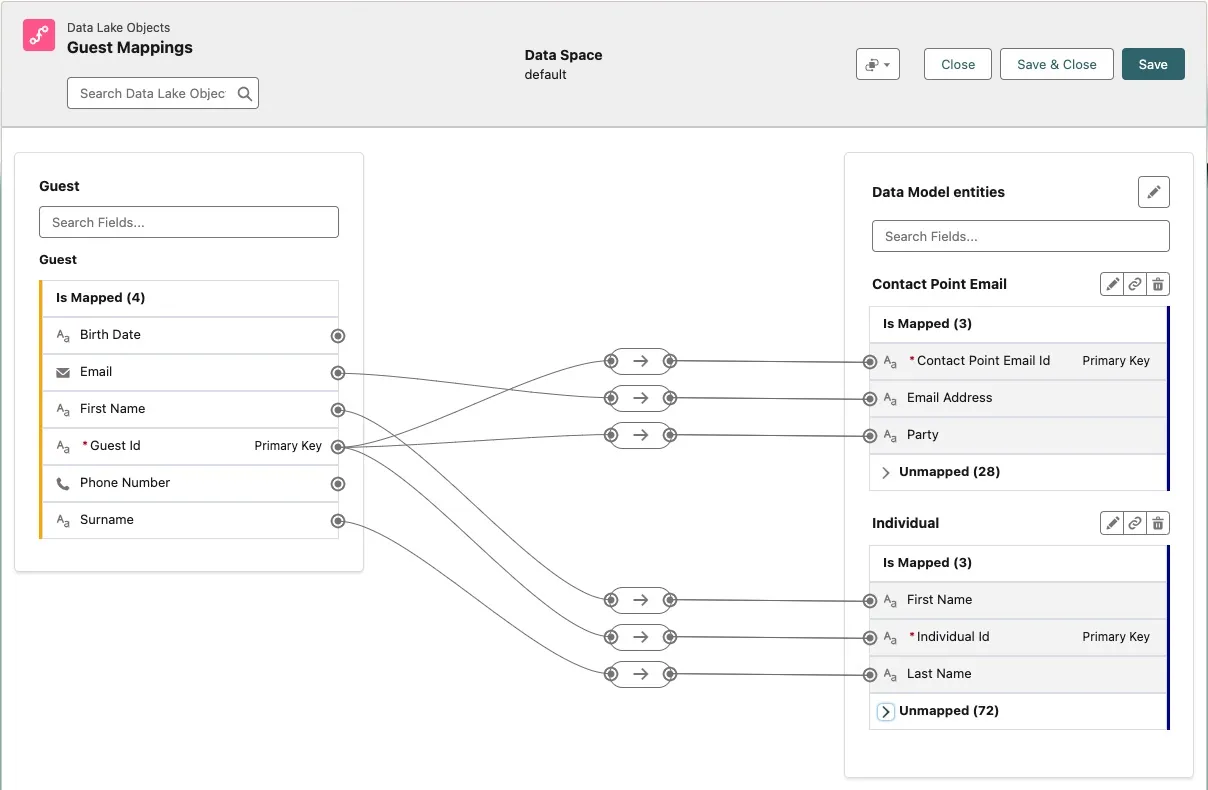Appearance
Exercise 3: Ingest Guests from Amazon S3
Coral Cloud Resorts stores Guest information in Amazon S3. In this exercise, you will:
Create a data stream that ingests guests into Data 360.
Map the Guest data lake object to the Individual data model object.
Step 1: Create the Guest data stream
In this step, you'll create a data stream that ingests Guests from Amazon S3.
Using the App Launcher, open the Data Cloud application.
Click the Data Streams tab.
Click New.
Under Other Sources, click Amazon S3, and click Next.

Configure the data stream with the following values:
Field Value Connection Coral Cloud Resorts S3 ConnectionFile Type CSVImport from Directory Leave blank File Name Coral_Clouds_Guests.csvSource Keep default: AwsS3_Coral_Cloud_S3_Connection
Click Next.
Continue configuring the data stream with the following values (keep the default values for all other fields):
Field Value Data Lake Object Label GuestData Lake Object API Name Keep default Category ProfilePrimary Key Guest IdEmail Data Type EmailPhone Number Data Type PhoneUse the screenshot below to make sure you set all the right values.

Click Next.
Keep the default values, and click Deploy.
Click the Refresh Now button to populate the Guest data lake object.
Keep the default option and click Refresh Now.
Click the Data Lake Objects tab, and notice that a Guest data lake object (DLO) has been created.
Step 2: Map the Guest data lake object
In this step, you'll map the Guest data lake object to the Customer 360 Data Model objects.
Click the Data Lake Objects tab, and click the Guest data lake object.
Click the Start button in the Data Mapping panel on the right.
In the Data Model entities panel on the right, click the Select Objects button.
In the Select Objects panel, search for the Individual object and click the + button. If the section expands, click the + button again. Make sure that you see the green tick before moving to the next step.

Now search for the Contact Point Email object and click the + button. If the section expands, click the + button again. Make sure that you see the green tick before moving to the next step.

Click Done.
Make sure that you see the two data model objects you selected on the right-hand side: Contact Point Email and Individual. The First Name and Surname fields from the Guest DLO have been mapped automatically to the First Name and Last Name fields of the Individual DMO.

Apply the following mappings by first clicking the field that you want to map on the left, and then clicking the field that you want to map it to on the right. Some of the fields you need will be in the Unmapped section of each DMO. You can easily find a field by using the Search box to narrow down the list.
Data Lake Object DLO Field → Data Model Object DMO Field Guest Guest Id → Contact Point Email Contact Point Email Id Guest Guest Id → Contact Point Email Party Guest Email → Contact Point Email Email Address Guest Guest Id → Individual Individual Id Guest First Name → Individual First Name (mapped by default) Guest Surname → Individual Last Name (mapped by default) Make sure that your mappings are correct using the screenshot below as a reference.

Click Save & Close. You can ignore any warnings about logging.
Summary
In this exercise, you created a data stream to ingest guest data from Amazon S3 into a Guest data lake object (DLO). You then mapped the DLO's fields to the corresponding fields in the Customer 360 Data Model.
Salesforce Contacts and S3 Guests are now available from the same data model object: Individual (and its related objects like Contact Point Email and Contact Point Phone). This will make it easy to access and act on guest data in a consistent way.